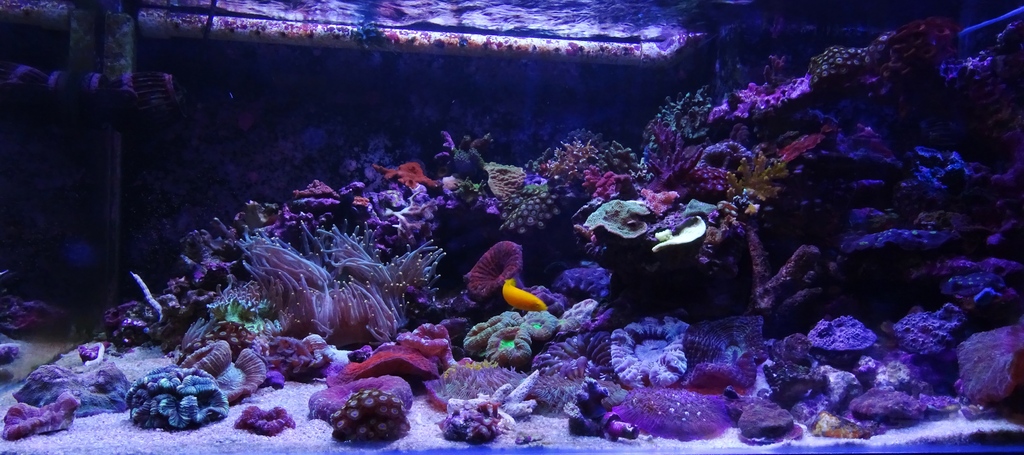How are you liking the mineral mud?Refugium only with 4 trays of mineral mud and a few little mangroves.
Navigation
Install the app
How to install the app on iOS
Follow along with the video below to see how to install our site as a web app on your home screen.
Note: This feature may not be available in some browsers.
More options
You are using an out of date browser. It may not display this or other websites correctly.
You should upgrade or use an alternative browser.
You should upgrade or use an alternative browser.
Microbial nitrate removal.
- Thread starter jeremy.gosnell
- Start date
- Tagged users None
I don't think I could run the tank without it, I don't run a skimmer or reactors, no filter socks or floss.
Last waterchange was 3 or 4 months ago.
I think it adds the little something extra that allows me to not do the waterchanges.
I have never tested nitrates or phosphates ( the tank is about 9 months old), I designed the tank to run as a natural system, took months for it to start to settle.
About 2 or 3 weeks after adding the mineral mud it was a big corner was turned and everything just looked brighter and my algae issues lessened.
Could have been a coincidence I guess!
Yesterday.

Last waterchange was 3 or 4 months ago.
I think it adds the little something extra that allows me to not do the waterchanges.
I have never tested nitrates or phosphates ( the tank is about 9 months old), I designed the tank to run as a natural system, took months for it to start to settle.
About 2 or 3 weeks after adding the mineral mud it was a big corner was turned and everything just looked brighter and my algae issues lessened.
Could have been a coincidence I guess!
Yesterday.

- Joined
- Mar 10, 2016
- Messages
- 61
- Reaction score
- 67
Thank you for this summary. My brain was scrambling trying to sort all this new information outOften, hobby level discussion of bio-pellets simply refers to the pellets as cultivating "bacteria". To a certain extent, this is accurate, as bio-pellets don't simply encourage the growth of one type of bacteria. Often there is a mixture of aerobic, anaerobic and other microbial strains living within a bio-pellet reactor. As mentioned, it's denitrifying (anaerobic) bacteria that convert nitrate into nitrogen or other compounds. This mass mesh of bacteria is what can cause cyanobacteria outbreaks, if the exhaust from a bio-pellet reactor isn't directed into a protein skimmer chamber, which can then remove the majority of the bacterial colonies before they make their way throughout the tank. The flow rate through a bio-pellet reactor should not be rapid, just enough to get a slight tumble from the pellets. This tumble is useful to "slough off" bacterial film ensuring the surface area of the pellets are open for bacteria colonization.
The best option for de-nitrification really depends on each individual system. For most aquarists simply looking for an inexpensive, easy way to reduce nitrates - a sulfur nitrate reactor is likely the best option. For aquarists looking for an entire approach to maintaining their aquarium, zeolite is likely the best. For moderately stocked tanks, a refugium will likely work fine. However, anything running nitrates of 10 ppm or more consistently will need a dedicated nitrate reduction option and likely fare best with a sulfur based reactor.
jsker
Reefing is all about the adventure
View Badges
Staff member
Super Moderator
Partner Member 2024
Excellence Award
Reef Tank 365
Article Contributor
Hospitality Award
Ocala Reef Club Member
R2R Secret Santa 2023
My Tank Thread
@jeremy.gosnell Another good write up, I read this just after you posted it I slowed down my bio pellet reactor. Thank you for the good points. It interesting that you covered the sulfur reactor, I was looking into the sulfur reactor if the bio pellet reactor did not work.
Similar threads
- Replies
- 1
- Views
- 95
- Replies
- 3
- Views
- 117
- Replies
- 6
- Views
- 337
- Replies
- 2
- Views
- 123
- Replies
- 3
- Views
- 113












